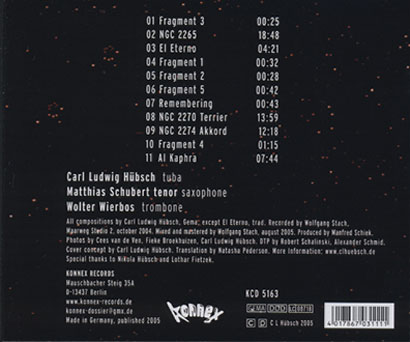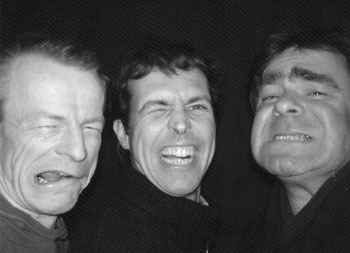
Carl Ludwig Hübsch's Longrun Development of the Universe 2
![]()
Go to the mailorder page

Calling on the talents of two other experienced Euro improvisers, Hübsch’s compositions substantiate the idea that three brass-like instruments manipulated with confidence can provide all the hues needed for a satisfying improv performance. “Brass-like” is more than a figure of speech on the CD, since the saxophone, here played by Matthias Schubert, was initially envisaged as the bastard stepchild of both the brass and the woodwind family. An experienced soloist and another Cologne resident, who often works with alto saxophonist Frank Gratkowski, Schubert is cognizant enough of the saxophone’s history to utilize that brass-like tradition in a variety of ways. The third member of the rather grandly named Longrun Development of the Universe trio is inventive Amsterdam-based trombonist Wolter Wierbos, who has proven his innovative mettle in bands ranging from the ICP to American drummer Gerry Hemingway’s quintet.

Segmented into many parts, the nearly 19-minute “NGC 2265” is an exercise in triple counterpoint. Initially directed by mellow, bottom-heavy tuba smears, fortissimo and pianissimo tones eventually give way to buzzed brass mouthpiece action plus distinct reed smears and tongue-stops. Circular breathing from all three develops polytonally into linear movement with Schubert supplying frenzied yips, Hübsch panting puffs, and Wierbos sprawling pedal point. As the saxophonist persists in blowing colored air through his body tube, the two low-brass instruments intermingle and vibrate modulated grace notes, then three-quarters of the way through the tune break apart, then harmonize again in a tango-like strut with tremolo
vibrations. This dance-oriented congruence lasts only so long and is succeeded by a final adagio section of plunger
trombone textures, sibilant stops and peeps from the saxophone, and steady subterranean emphasis from the tuba.
Hübsch’s barking tuba tones, followed by double counterpoint from the other horns, characterizes “NGC
2270 Terrier”. But soon his bouncy polyphony is sabotaged by reed whistles from Schubert and textural blasts from
Wierbos. In response, the tubaist sounds almost literal nose-blowing pitches. Speedily emphasizing the tactile roughness
of the buzzing metal, the trio builds to a crescendo of droning vibrations, then quickly exits with jaunty, unison tongue-stopping.
In contrast, “NGC 2274 Akkord” shows that these contrapuntal actions can be expressed more leisurely, with
each instrumental part moving in a parallel line, but never quite touching. At times the saxophone-trombone interaction
is reminiscent of 1970s Anthony Braxton-George Lewis duets. Elsewhere Hübsch’s tuba provides buzzing commentary
on the other two’s interface, until all three compress sounds into razzing short phrases, then subdivide that into
single notes. Finally, there’s “Al Kaphra”, an offbeat, pan-tonal collection of dancing reed
and brass riffs that moves from gutbucket explosions from Wierbos and pedal point spits from Hübsch into a finale
of staggering shape-shifting from all three, ending in a crescendo of pleasantly vibrated timbres.
Ken Waxman at UnAmerican Activities #92

Neue Zeitschrift für Musik 5-06
Zu recht ist der Tubaspieler Carl Ludwig Hübsch stolz auf dieses Trio mit Matthias Schubert (Tenorsax)
und Wetter Wierbos (Posaune). Schließlich sind sich diese drei Musiker wunderbar einig bei dem, was sie da tun!
Es ist eine Blasmusik improvisierter und komponierter Natur mit sehr hohem Abstraktionsgrad, sodaß stilistische
Bezüge bzw. Einflüsse kaum ausmachbar sind und auch nicht angebracht sind. So banal das klingt: Hübsch,
Schubert und Wierbos bedienen sich der modernsten Formen der Musik jenseits der Stilbegriffe und konventionellen Gestaltungsmittel
und spielen mit völligem Einverständnis wundervolle Musik. Der Name ihres Trios verweist auf die Ruhe und Geduld,
mit der sie ihre Musik entstehen lassen. Dabei entstehen Stücke, die 20 Minuten dauern können, oder schon nach
20 Sekunden zuende sind.
Nicht unrecht hat Peter Niklas Wilson in seinen Liner Notes zum ersten Album von Longrun Development Of The Universe
(erschienen 2001 bei JazzHausMusik), wenn er die Arbeit des Trios vergleicht mit ähnlichen Projekten Anthony Braxtons,
der schließlich auch in den Bereich jenseits von Freejazz und Moderner Komposition vordringt. Mit dem Titel des
aktuellen Albums 'Is This Our Music?' spielt Hübsch auf das klassische Ornette Coleman Album 'This Is Our Music'
an, welches damals ebenfalls entschlossen in die Zukunft wies. Doch Hübsch, Schubert und Wierbos betonen, daß sich
Musik entwickelt, oft langfristig, und daß die Frage nach der Gestalt seiner eigenen Musik spannender ist als eine
vorschnelle, möglicherweise dogmatische Antwort.
Is This Our Music?' - diese Frage wird an die Hörerschaft weitergegeben. Und es lohnt sich in der Tat, dieser Frage
nachzugehen - mit der Musik dieses famosen Albums im Ohr natürlich!
My Way 60